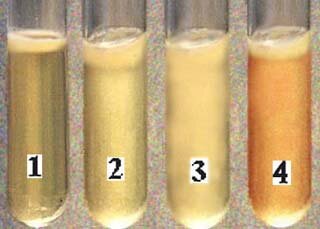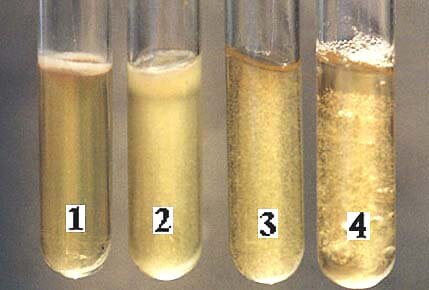Differential Media:
|
|
|
|
|
||
|
In Bergey's Manual and other bacteriological texts, reference is made to the oxygen relationships of various bacteria – that is, how bacteria metabolize and replicate (if at all) in the presence or absence of oxygen. Molecular oxygen (O2) is the electron acceptor utilized by organisms which obtain energy from respiration (i.e., aerobic respiration). However, it does not function as such for organisms which obtain energy from fermentation, photosynthesis or anaerobic respiration. For the following discussion, it may be helpful to review basic catabolic processes such as what is covered on this page. Also, a review of respiration vs. fermentation is given here. I. In the most elementary sense, living organisms can be classified according to "oxygen relationships" as follows: (1) strict (or obligate) aerobes – those which require O2, (2) strict (or obligate) anaerobes – those which can only grow in the absence of O2, and (3) facultative anaerobes – those which can grow in the presence or absence of O2. Practicing bacteriologists do not settle for this oversimplification as we see in the following two sections. II. Bergey's Manual applies oxygen relationship categories to the chemotrophic bacteria, and the definitions which follow are taken verbatim from those in Bergey's Manual of Determinative Bacteriology (9th ed., 1994) except for the items in brackets:
With these Bergey's Manual definitions, phototrophs would be categorized with difficulty if at all. As one example, the purple non-sulfur photosynthetic bacteria can respire and can also grow anaerobically, but anaerobic growth is associated with the organisms' use of energy derived from light, not (except for certain exceptional strains and species) from fermentation or anaerobic respiration. III. Thioglycollate Medium – which we utilize in our Bacteriology laboratory courses – is a "standard" medium for the determination of oxygen relationships, and it will support the growth of common, easily-grown chemoheterotrophic bacteria. The observed growth patterns of organisms in this medium determine their oxygen relationship designations (strict aerobe, facultative anaerobe, etc.) which correlate with such physiological abilities as respiration, fermentation and the catalase reaction and also whether there is an inhibitory effect on the organism in the presence of air. See the table under the photo below. Thus, a description of a chemoheterotrophic organism as a "strict aerobe" can imply a number of associated characteristics that may be unnecessary to specify separately (able to respire, unable to ferment, catalase-positive, azide-sensitive, etc.). The amino acids and glucose in the medium can be respired, and glucose is the only fermentable energy source in the medium except for those exceptional organisms such as certain species of Clostridium which can ferment amino acids. With Thioglycollate Medium, we are able to differentiate two distinct patterns of growth for those classified in the Bergey's Manual definitions (above) as "facultative anaerobes":
One must consider the following limitations of Thioglycollate Medium:
The results we see in Thioglycollate Medium are shown below. (Note that microaerophiles are not included.) The accompanying table gives related information.
|
| Corresponding tube no. above | 1 | 2 | 3 | 4 |
| Oxygen relationship designation | STRICT (OBLIGATE) AEROBE |
FACULTATIVE ANAEROBE |
AEROTOLERANT ANAEROBE |
STRICT (OBLIGATE) ANAEROBE |
| Aerobic respiration* | + | + | – | – |
| Fermentation* | – | + | + | + |
| Ability to grow aerobically (oxygen tolerance) |
+ | + | + | – |
| Ability to grow anaerobically | – | + | + | + |
| Catalase reaction | + | + | – | – |
| Reaction in Glucose O/F Medium (for those able to grow well in medium) |
O or – | F | ||
| Response to sodium azide in a growth medium |
SENSITIVE | SENSITIVE (under aerobic conditions) |
RESISTANT | RESISTANT |
|
* These are the basic things tested for in this medium. Whether or not any organism can obtain energy by anaerobic respiration or phototrophy is not relevant to these designations of oxygen relationships. So, in becoming a practicing bacteriologist, one will see that there is more to this concept than whether bacteria simply "like" or "don't like" oxygen – which, unfortunately, is the extent to which oxygen relationships are too-often and unconscionably taught. IV. Rather than (or in addition to) using "oxygen relationships" as descriptive terms – however they may be determined or defined – we can characterize and classify bacteria more consistently and comprehensively by applying the method(s) of energy generation of which an organism is capable:
Remember that Thioglycollate Medium tests for an organism's ability to perform aerobic respiration and/or fermentation – the results of which give us the "oxygen relationship" categories for those organisms which can grow in the medium under the incubation conditions provided. Anaerobic growth in this medium is only associated with fermentation. V. The following summary may help to explain how media formulations can allow anaerobic growth for organisms capable of doing so for one reason or another. The same organism – a typical strain of E. coli – was inoculated into tubes 1, 2 and 3, and a "facultative phototroph" was inoculated into tube 4. 
In Tube #1, we have a medium containing peptone and agar plus other nutrients a "typical Bacteriology 102 organism" (i.e., a commonly-found, easy-to-grow chemo- or photoheterotroph) might require for metabolism and replication – except that nothing is included which would support anaerobic growth such as glucose (or something else that could be fermented) or nitrate (or some other electron acceptor/"oxygen substitute" that could be used in anaerobic respiration). After inoculation of this medium and incubation in the dark, any growth would be due to aerobic respiration with the growth only at the top of the medium. There would be no anaerobic growth except for some rare, exceptional organisms which can ferment amino acids; these we do not consider in Bact. 102. Tube #2 is the same medium as in #1, but glucose has been added. After incubation (in the dark), any anaerobic growth would be due to fermentation of the glucose. Thus the medium can be used to detect whether or not an organism can respire (aerobically) or ferment. An example of such a medium is the Thioglycollate Medium we use to test common chemoheterotrophs for "oxygen relationships" (discussed above). Tube #3 is the same medium as in #1, but potassium nitrate has been added. After incubation (in the dark), any anaerobic growth would be due to anaerobic respiration where the organism is using nitrate as the electron acceptor. In Bact. 102 (Exp. 7), we do a test in a broth medium for nitrate reduction; with reagents we can detect nitrite formation, and with the Durham tube we can detect N2 gas formation. One can probably see why we would not want to include nitrate in the Thioglycollate Medium above. Tube #4 is the same medium as in #1, but we have incubated the tube in the presence of light. With light as the ultimate energy source, anaerobic growth would be due to anoxygenic phototrophy. This is the basis for the test we do in Bact. 102 (Exp. 11.1) to see if our isolates of purple non-sulfur bacteria are either "strict phototrophs" (just anaerobic growth in the light) or "facultative phototrophs" (anaerobic growth in the light, plus aerobic growth due to aerobic respiration whether in the dark or the light). Click here for a summary of this test. A relevant quiz/exam question which we repeatedly give in Bact. 102 is shown here. |
|
A special page on Thioglycollate Medium that may be suitable as a handout can be found here. |
|
Return to the main page |
These general microbiology pages have copyright by John Lindquist |
